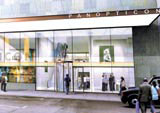Libraries read between the lines
Public libraries need to shed their moth-eaten image to attract a younger crowd, says Anne Konopelski

Step into many public and academic libraries, and you could be forgiven for wanting to step right back out again. More often than not, banks of computer terminals and shabby furniture vie for space in dingy interiors with row upon row of book-laden metal racking.
But a recent crop of library development projects looks set to repair the sector’s battered image. Last week, Hampshire County Council (HCC) unveiled plans to convert ten of its libraries to new-concept Discovery Centres, as part of a wholesale refurbishment of the county’s sites (DW 8 July).
Designed by HCC’s in-house architectural team, the centres will still have traditional library services at their core, but they will also boast cafés, meeting and relaxation rooms, updated information technology and, in some cases, exhibition and events areas.
University College London’s (UCL’s) special collections library has also been earmarked for a makeover. In 2008, it will move to a nine-storey new-build museum and exhibition space called the Panopticon, designed by architect Dixon Jones (DW 24 June).
Its book-lined reading room, which will occupy a third of the Panopticon’s top floor, will be suffused with daylight from a series of 6m-long roof lights. Glass walls will separate it from adjacent exhibition and activity spaces, lending the floor a feeling of transparency.
This increased interest in libraries’ environments and services is a fairly recent phenomenon, says Chartered Institute of Library and Information Professionals (CILIP) head of policy and governance Guy Daines. ‘The first to [tackle these issues] was the [Alsop Architects-designed] Peckham Library, which started it all when it opened in 2000,’ he says.
He points to public libraries in Bournemouth and Stratford (Newham), and the London School of Economics’ Foster & Partner’s-designed venue as good examples. ‘Suddenly, library design is right at the heart of what we [CILIP] do.’
As far as Daines is concerned, this shift in focus could not have come soon enough. ‘A lot of existing libraries are situated in fairly forbidding Victorian buildings, made even more intimidating because they’ve not had a lick of paint in years,’ he says.
‘These [recent projects] are resulting in exciting buildings. Gone is the municipal look. They’re trying to express the excitement that should be happening inside – particularly in public libraries, which should be fun, inclusive, family-friendly and flexible.’
Generating enthusiasm is at the crux of Hampshire County Council’s Discovery Centres initiative, says HCC head of libraries and information, Richard Ward. ‘We’ve got to continually reinvent ourselves to make sure that customers find our services attractive,’ he explains.
The Discovery Centres are largely a response to HCC’s market research, which revealed that the region’s libraries no longer carry much weight with its 24- to 54-year-old demographic, he adds.
‘They’re not using library services like they used to. They want to see services collated in one place. They want to be able to buy a cup of coffee, surf the Internet, borrow DVDs and get tourist advice. Yes, books need to remain at the centre of the library service, but it now needs to be about much more than that.’
Ward says the push for multi-use libraries is just the latest in a string of challenges that libraries have faced since the 1950s. ‘In the 1950s and 1960s, when library usage was at its highest, people had two black-and-white TV channels; but by the early 1970s, colour TVs were more affordable; VCRs were in development; there was the resurgence of cinema; and the [advent] of retail as recreation.’
Ward claims that if libraries are to survive, they must ‘go with the flow of society’. This is fighting talk, but will the Discovery Centres really differ much from the familiar library template?
The short answer is, yes. Apart from being one-stop shops, and open longer hours, their interiors will be a far cry from the much-maligned ‘municipal’ aesthetic. The council is going for a ‘light and bright and new environment’, according to HCC Architects architectural team leader Alec Gillies. ‘They’ll be very open, transparent and flexible, with movable shelves and an open-plan layout,’ he says.
‘Open’ is also the watchword for UCL’s forthcoming special collections library, according to the college’s senior sub-librarian, Janet Percival. ‘We have a wide range of material that nobody knows is here. This [project] is all about attracting people and showing them what we’ve got,’ she says.
Dixon Jones architect, Nicholas Pawlik, says that other libraries could benefit by adopting this approach: ‘Libraries are dogged by a stigma of being terribly serious places. They’re viewed as places of boredom. It would only help to make them areas of discovery and interest. Having [different] amenities next to each other is valuable.’
CILIP’s Daines sees a pleasing symmetry in our modern-day interest in well-appointed, multipurpose libraries. ‘Libraries, as we recognise them now, started out in the 1840s as extensions of museums,’ he says. ‘This emphasis on co-locality, to adopt a Government term, and creating a service that’s greater than the sum of its parts is like saying, “They had something good, those Victorians.”‘
-
Post a comment




